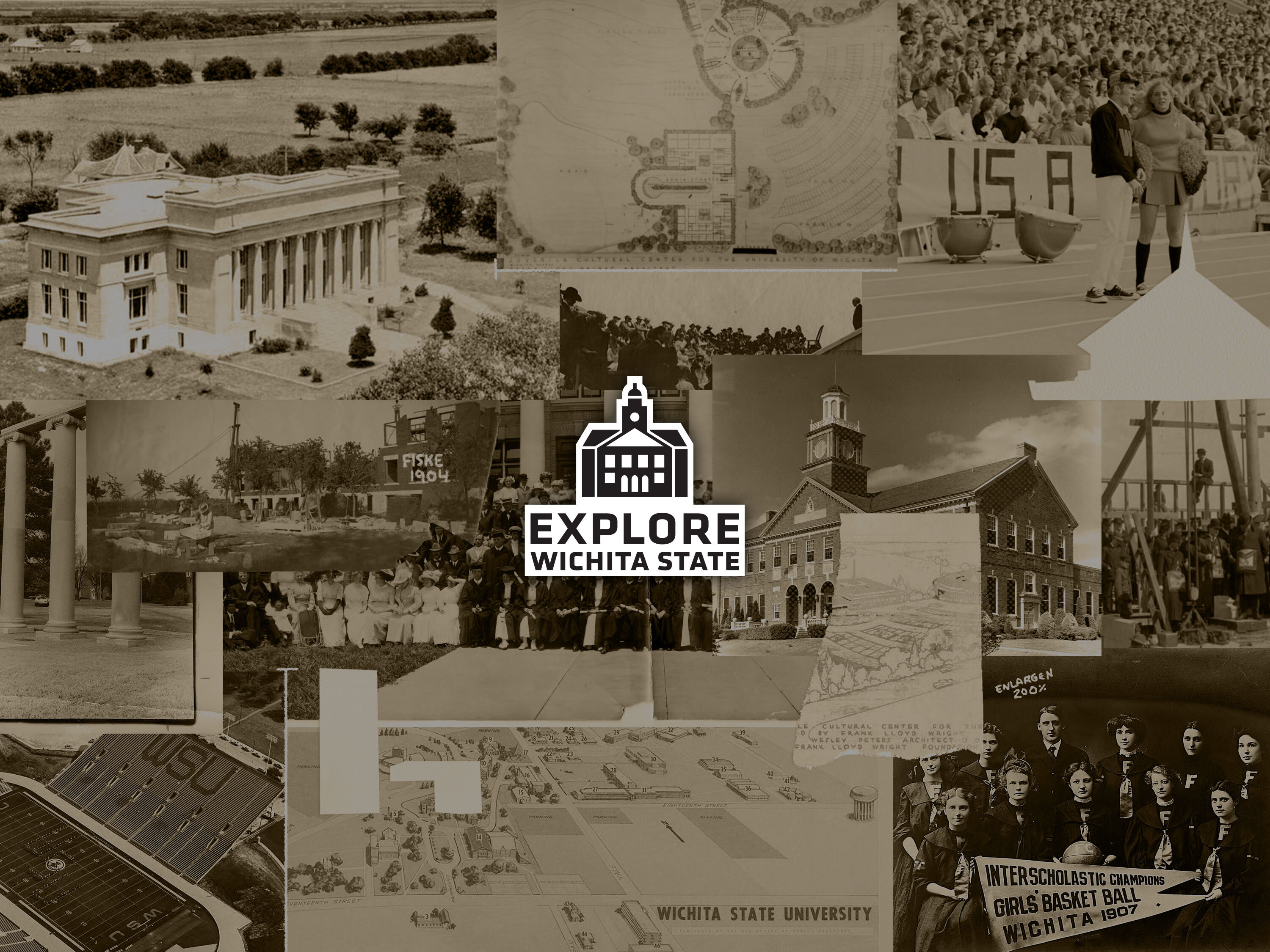Walk through Shocker Nation's history with this self-guided audio tour of campus, offered in-person and virtually.
There are four ways to take the tour, depending on your preference.
Virtual tour
The virtual tour option plots the tour stops on Wichita State's interactive campus map.
Take the virtual tourBrowse by stop
Click or tap the bars below to learn more about each stop or see the stop's location on the interactive campus map.
Spanish artist Joan Miró’s Personnages Oiseaux (Bird People) has brightened and inspired since its installation in the fall of 1978. It adorns the façade of the Ulrich Museum and is one of Miró’s largest works in the United States and his only glass mosaic mural.
View the Ulrich Museum on a mapThis pedestrian corridor used to be Alumni Drive — a road through campus. After the campus master plan was developed in 2013, it was determined that one of the goals was to make WSU more pedestrian friendly. The circular seating area and Echo Spot were added as a focal point for people to gather along the walkway.
View Alumni Walk on a mapOpened in August 2020, the Student-Athlete Center is a 36,000-square-foot facility devoted to the academic and athletic development of students in Wichita State’s sports programs. The two-level building, located just south of Charles Koch Arena, houses study and tutoring spaces as well as Wichita State’s track and cross country programs.
View the Student-Athlete Center on a mapIn 1957, the College of Education (now Applied Studies) commissioned architect Frank Lloyd Wright to design learning spaces for the college. Corbin Education Center is the product of the commission, and remains the home of the college today, with its distinctive polished plate glass and stone aggregate.
View Corbin Education Center on a mapWhen Fairmount College became the University of Wichita, a common objective was construction of an nonsectarian chapel to serve the university community and represent a tie to the institution’s beginning as a Congregational college. The building was designed to reflect Mr. Grace’s heritage in the rural churches of Denmark with their thatched roofs. The dedication plaque in the foyer reads 'This chapel is to be open to all creeds and all races of people.'
View Grace Memorial Chapel on a mapIn the early days of Fairmount College, women students lived in Holyoke Cottage. In 1904, work began on a permanent dormitory for men, thanks to the donation of Charlotte Fiske. Dedicated in June of 1906, Fiske Hall housed young men on three floors with a dining room and kitchen in the basement.
View Fiske Hall on a mapUniversity of Wichita alum Kathlien Edmiston protected the Morrison Columns from bulldozers when construction threatened the artifacts from Fairmount College. She then played a lead role in raising money to preserve the columns in 1972, when the university moved three to the entrance at Fairmount and 17th.
View the Carnegie Library Columns on a mapFull audio
If you'd prefer to play the full audio clip on your phone, earphones or bluetooth speaker as you follow along, start by facing the colorful Miró mural on the south side of the Ulrich Museum of Art. Visit the link below and press play when you're ready to start the tour:
Full tour audio Audio tour transcriptText-only tour
This option works well with screen-reading technology.
Text-only tourAdditional points of interest
The following landmarks are not included in the list of Explore Wichita State self-guided tour stops, but they add important historical context that we wanted to highlight. Some of these points of interest are referenced in the tour's audio clips.
In one of the worst tragedies of college sports history, a plane carrying Wichita State University football players, athletic staff members, and team boosters crashed at approximately 3 p.m. on Oct. 2, 1970, on a mountain near Silver Plume, Colorado, while en route to Logan, Utah, for a game with Utah State University.
The Memorial 70 sculpture was dedicated on Nov. 28, 1971, bearing the names of the 31 people who tragically died in the Gold Plane crash. It was a culmination of the efforts of hundreds of concerned individuals both inside and outside the university community. The architectural firm was Schaefer, Schirmer and Eflin. The general contractor was Dondlinger and Sons Construction Co.
Near the southeast corner of the monument is the Randy Jackson Survivor Tree, planted in the spring of 2010. The Bel Aire Tree Board donated the sapling in memory of crash survivor Randy Jackson, who passed away in July 2020 after a battle with pancreatic cancer. The tree is a seedling from the 100-year-old American elm that survived the Oklahoma City bombing blast on April 19, 1995.
For 49 years the memorial remained unchanged. In fall 2020, augmentations were made to enhance the beauty of the living memorial as a place of remembrance in honor of the lives affected by the tragedy. Installed in October 2020, the Survivors' Monument bears the names of the eight WSU players who survived the crash of the Gold Plane on Mount Trelease on Oct. 2, 1970. It is positioned between the two original Memorial 70 structures. The names of the Black Plane passengers were added to the south side of the memorial that same year.
Randy Phillips and Bill Moore worked to bring the memorial enhancements to fruition for Memorial 70's 50th observance. The idea for the addition of the survivors’ names and the names of the passengers of the Black Plane came from Randy Phillips. Randy transferred to Wichita State in 1971 to play quarterback and help the team rebuild. Bill Moore stepped up to help Randy by starting a fundraiser to pay for the additions to complete the story with the help of Ann Marie Siegwarth at the Wichita State University Foundation. Randy is a partner at the Wichita architectural firm of Spangenberg Phillips Tice Architecture. The tributes to the survivors and the Black Plane were designed by Randy Phillips with help from graphic designer Jason Ridder. The installation was completed by Miracle Sign Co.
A quote from then-Wichita State President Clark Ahlberg from the original November 1971 dedication date reads:
Former president, Wichita State
Memorial 70 has been a living monument to the love and our remembering of those that died as a result of the Gold Plane crash. It is also a monument to those who survived the Gold Plane crash and those who landed safely on the Black Plane in Utah who mourn their friends and colleagues.
Learn more about Memorial 70Henry Roe Cloud, a Winnebago whose original name Wohnaxilayhungah, became the first Native American to graduate from Yale and, in 1915, founded the Presbyterian-affiliated Native American Institute east of Fairmount College. Called the “Roe Cloud School,” this college preparatory school for Native Americans functioned until 1935. Roe Cloud had, by this time, been appointed to head the United States Indian Industrial Training School.
When the pizza craze started sweeping the nation in the late 1950s, two young college students, attending the University of Wichita at the time, opened the first Pizza Hut restaurant on June 15, 1958. Brothers Frank and Dan Carney had been approached by the owner of a small building at the corner of Kellogg and Bluff, who wanted a nice neighborhood business to locate there and she had read a November 1957 Saturday Evening Post article about the pizza craze. The building's structure influenced the name of what would become a well-known international chain. The building had a sign that would only accommodate nine characters. The brothers wanted to use "Pizza" in the name and that left room for only three more letters. A family member suggested that the building looked like a hut — and Pizza Hut was born. The first Pizza Hut building was moved to the WSU campus to serve as a symbol and reminder to WSU students that young individuals through hard work and initiative can rise from modest beginnings to positions of leadership and success. It was dedicated on campus September 11, 1986. The building originally served as a headquarters for WSU's Association of Collegiate Entrepreneurs. Other business student chapters, including most recently the International Business Student Association, have used the facility as a meeting place. Today, the original building resides at Wichita State as a museum.
View Pizza Hut on a mapKirby's Bar is something of a WSU tradition, serving the Shocker community since 1972. The hole-in-the-wall bar has a packed live music calendar and was named one of America's Top 5 Dive Bars by Playboy magazine.
Kirby's is not affiliated with Wichita State University.
View Kirby's on a map




